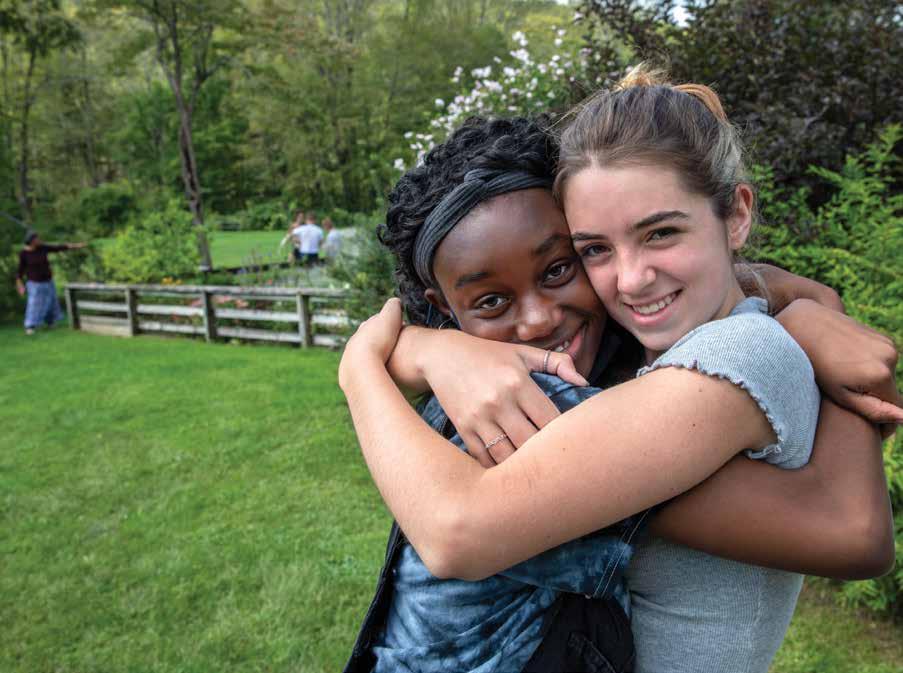
37 minute read
Progress Toward Equity
A New Bridge Program Helps Preps Navigate Their First Year
BY WENDY CARLSON
ON A CRISP SEPTEMBER morning at Fairfield Farm, a group of preps barely took note of a tractor rumbling and sputtering past the field where they were busily digging potatoes and marveling at the abundance of earthworms. Nearby, at the Sharon Audubon Center, another group of Bridge Program students chatted nonstop as they pulled weeds from the Center’s extensive flower garden; yet another group, equipped with bow saws, worked as a team to tackle invasive brush at a neighboring land trust property.
The endeavors were all service projects for the 31 students enrolled in the School’s inaugural Bridge Program, designed to help preps from diverse academic, socioeconomic, and geographic backgrounds ready themselves for campus life at Hotchkiss. Community outreach work — pulling weeds, digging potatoes, or blazing trails — is an important part of the overall Hotchkiss experience, according to Instructor in Physics Anju Taneja P’04,’09, who worked with the students over the summer to help them design their own service projects.
For two weeks in August, Bridge students gathered virtually to discuss both academic preparedness and community service in order to ease their transition to Hotchkiss in the fall. They met with instructors in English, math, and history to brush up on writing skills, participated in class discussions, learned about expectations in their individual math levels, and reviewed basic research methods. But as importantly, they forged a connection as a group, laying the groundwork for strong friendships that should help them overcome hurdles in the year ahead.
The Bridge Program at Hotchkiss had been in the planning stages for several years as part of the School’s efforts to attract and support a broader range of students, according to Dean of Admission Erby Mitchell P’22.
“Students in our Bridge Program are racially, ethnically, and geographically diverse, and they possess a range of interests,” Mitchell said.
“Far too often, programs like these are stigmatized as remediation for weaker students, but that misses the point,” says Mitchell. “This program is about enabling capable students to thrive, and contrary to expectations, this group reflects racial,
PHOTO: WENDY CARLSON
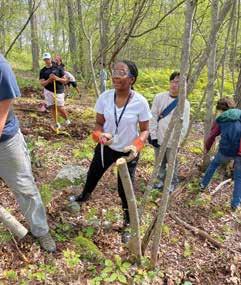
PHOTO: BEN SORKIN
—CHRISTINA COOPER P’08,’11
ethnic, and geographic diversity and also includes some full-pay kids.”
In 2017, Mitchell visited Stanford University with Hotchkiss Trustee Chris Redlich ’68. He met with the dean of admission to talk about how they create excellence. “Stanford, and other schools like it, take pride in their bridge programs,” he explains. “I am proud to have such a program at Hotchkiss, and I expect it to be an important part of what we do for many, many years.”
Instructor in History Sam Somera, who taught Bridge students this summer, noted the need for the program. “This year, Hotchkiss has brought in one of the most diverse prep classes, and with that diversity comes the need for some intentional thinking about how we
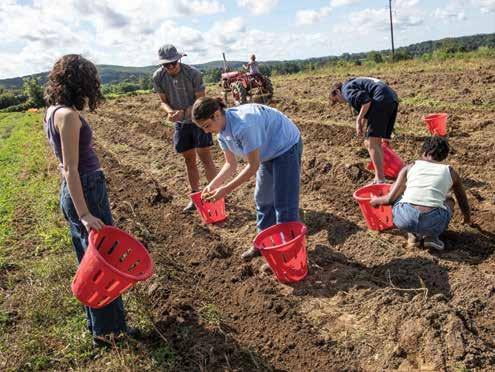
PHOTO: WENDY CARLSON
On left, students clear brush at Sharon Land Trust. Above, preps at Fairfield Farm get to know each other and the Hotchkiss experience.
are bringing these students from many different backgrounds into the fold of the Hotchkiss community.”
The English classes introduced students to the kinds of reading and writing assignments they would undertake at Hotchkiss and gave them a chance to hone their discussion and critical-thinking skills. They also learned about the academic support that would be available to them as well as the importance of asking for help, said Christina Cooper P’08,’11, English instructor and prep class dean.
“I think the students loved having a chance to get to know some of the other preps even before they arrived on campus,” she said. “I was fortunate to be part of it and impressed by how bright and engaged they were throughout!”
So far, feedback from students in the program has been exceptionally positive, according to Ben Sorkin, assistant dean of admission. “The students report feeling confident that they have the skills they need to succeed academically, the peer network necessary to thrive socially, and a group of adults that they can lean on for support as a result of participating in the Bridge Program.”
Ihsan Yumak, who hails from Queens, previously attended a junior high school with more than 1,200 students. The Bridge Program, he said, offered him a sneak peek at the comparatively smaller classes at Hotchkiss and how they would be structured and conducted.
“I went to a local public school previously where the workload was challenging, but having a look at the Hotchkiss curriculum really helped me prepare for what to expect this fall,” said Yumak. “We also had a chance to bond with a group of our future classmates, so it has been a massive success in preparing us both academically and socially for Hotchkiss.”
The program also helped students feel generally more at ease with the concept of boarding school. Brianna Bobbie arrived in Lakeville from Brooklyn, NY, and even though she wasn’t nervous about coming to Hotchkiss, she said, the Bridge Program has made her feel even more at home. “I made so many new friends, and I really enjoyed Opening Days.”
Elliot Hu, from Queens, agreed. “Seeing those familiar faces on campus helped me settle in,” he said. “On movein day a number of students from the program approached me, and it was like we’d known each other all along.” H
THIS SUMMER HOTCHKISS
welcomed to campus the first Walter J. Crain Fellows, Kinyette Henderson and Claudia McGuigan.
Kinyette Henderson is an English instructor and assistant director of the Diversity and Inclusion Office. She began her teaching career in New Orleans. Upon returning to her hometown of Newark, NJ, she remained in urban education. There, her academic journey came fullcircle when she accepted a job at the same middle school she attended as a student. Leading the 7th-grade team and writing curriculum, she focused on rebuilding the student experience and staff culture within the school. A graduate of The George Washington University in DC, she has studied literature and the history of racism, and culturally responsive pedagogy.
Since she arrived in Lakeville, Henderson has been impressed by the School’s DEI work. “Hotchkiss is doing a great job on the equity front by just asking questions and getting so many different people at that table to engage in these conversations — and by implementing the Walter Crain Fellowship and having people with an outside perspective intentionally come into the community,” Henderson said.
Instructor in Mathematics Claudia McGuigan joined the Hotchkiss faculty
Kinyette Hederson Claudia McGuigan
from the Westminster School. Previously, she taught at the Watkinson School in Hartford and served as the Associate Director of Equity and Justice. She earned her B.A. in French and Spanish with International Marketing from the University of Northumbria in her hometown of Newcastle-Upon-Tyne, U.K. She also earned a Licence from the Université de Bourgogne in France in 2005. She was a senior principal dancer with the Alabama Contemporary Dance Company and guest-starred with the Chuck Davis African-American Dance Company.
McGuigan looks forward to everything she will learn and achieve in her fellowship including developing her leadership skills and in particular, being an inclusive leader. “I’m really excited about the possibility of getting the Master’s in Educational Leadership from the Klingenstein Institute, having access to and being mentored by senior administrators at Hotchkiss, and also then having the chance to mentor other Walter Crain Fellows as they come down the line. Growing up in a very homogenous schooling environment, I didn’t realize how important representation was. I never had any teachers or any administrators in my school that looked like me or identified similarly to me. It’s really important for me to be that for somebody else,” she said. The fellowship program is the result of an innovative partnership between Hotchkiss and the Klingenstein Center, Teachers College, at Columbia University. Fellows pursue a Master’s degree in private school leadership from Teachers College Columbia while earning a salary teaching at Hotchkiss or working in one of the School’s administrative departments. The program is geared to professionals who aspire to leadership roles at independent schools and have shown a commitment to working with diverse populations and supporting an inclusive learning community for all students.
The program is named in honor of the late Walter J. Crain P’86,’89, a beloved teacher, advisor, and coach, and dean of students. He was the first Black educator on the Hotchkiss faculty. Over his 33 years at the School, Crain was dedicated to meaningful inclusion and belonging for all students, faculty, and staff. H

PHOTO: WENDY CARLSON
MULTICULTURAL CENTER OPENS
Students now have a place to gather, share, and celebrate the diverse cultures of the Hotchkiss community. The Multicultural Center (MCC), located at the heart of Main Building, adjacent to the campus store and post office, opened this fall to offer students a place of their own to gather for affinity group and advocacy club meetings, film screenings, open-mic nights, self-care afternoons, guest speaker presentations, and a range of other activities. “In the past, many student groups were using campus spaces that were not necessarily
Hispanic Heritage Month Celebrated with Guest Speakers, Latin Music, Flags, and More
HOTCHKISS WAS ALIVE with Latinx culture during Hispanic Heritage Month, which takes place every year from September 15 to October 15 as a time to recognize and honor the many contributions, diverse cultures, and extensive histories of the American Latinx community.
The month-long celebration kicked off Sept. 15 with a small gathering on Main Circle for the re-creation of “El Grito de Dolores,” a speech that sparked a decadelong war for Mexican independence on that day 211 years ago. That Sunday, nearly 30 students and three Latinx faculty members gathered at De Colores’s advisor David Thompson’s house for an asado, an outdoor meal. “The students were eager to connect with more of the adult members of the Latinx community at Hotchkiss and in the northwest corner,” explained Thompson, who also serves as the director of international programs at Hotchkiss. “It was truly moving for me to hear that the asado made Hotchkiss feel more like home for them,” he added.
Since De Colores was founded three years ago by Anaiz Robinson ’22, Billy Meneses ’22, and Suleyka Alonzo ’22, the group has focused on building awareness of the School’s Latinx community. To promote Hispanic Heritage Month, the group launched a rotating display of flags of Latin American countries represented at Hotchkiss.
De Colores worked with the Office of Diversity and Inclusion to organize a series of community events in the new Multicultural Center, which included an open-mic session with the Black and Hispanic Student Association (BaHSA) where students shared their experiences, read poetry, and performed monologues. On Sept. 24, artist Eilen Itzel Mena ’13 spoke about her journey as a Latinx artist.
In October, Latinx music filled the air during an outdoor dance held on Main Circle, and De Colores sold cups of horchata to the community to raise funds for Vecinos Seguros, a nonprofit that helps undocumented families in the local community.
Rounding out the month, special guest speaker Steven Tejada performed during an All-School Meeting, entertaining students with his stories of growing up in a Hispanic family in the South Bronx and his personal journey from dropping out of high school to attending an independent day school to graduating college. Tejada worked on Wall Street before becoming a performer and speaker, and also serves as head of the upper school at Maret School in Washington, D.C. H

PHOTO: DAVE THOMPSON
designed for meetings, whether it was the faculty lounge, the science lecture hall, or classrooms,” explained Director of Diversity and Inclusion Yassine Talhaoui. “The MCC was designed as a safe space where everyone can feel welcome and students can connect with one another, learn about and celebrate their differences, have meaningful discussions, and gain cultural competency and dexterity with the help of our team,” he added.
DEI OFFICE EXPANDS
Several new members joined the DEI team this fall, bringing fresh perspectives and insights to the School’s mission of building a more diverse and inclusive community. Lisanne Norman ’94, associate director of and instructor in humanities and social sciences, offers experience as an alumna and as a teacher. Kinyette Henderson, assistant director and instructor in English, was drawn to Hotchkiss because of the breadth of its DEI activity. For Pierre Yoo, assistant director, instructor in Chemistry, and Pan Asian advocacy leader, seeing students empowered is powerful. Jason Larson, director of religious and spiritual life and philosophy and religion instructor, sees opportunities to explore the intersectionality of race and religion. David Thompson, director of international programs and advisor to De Colores, aims to encourage a campus culture of empathy toward others and engage in honest, open dialogue.
READ MORE ABOUT OUR PROGRESS TOWARD EQUITY ON THE NEW DEI WEBSITE.
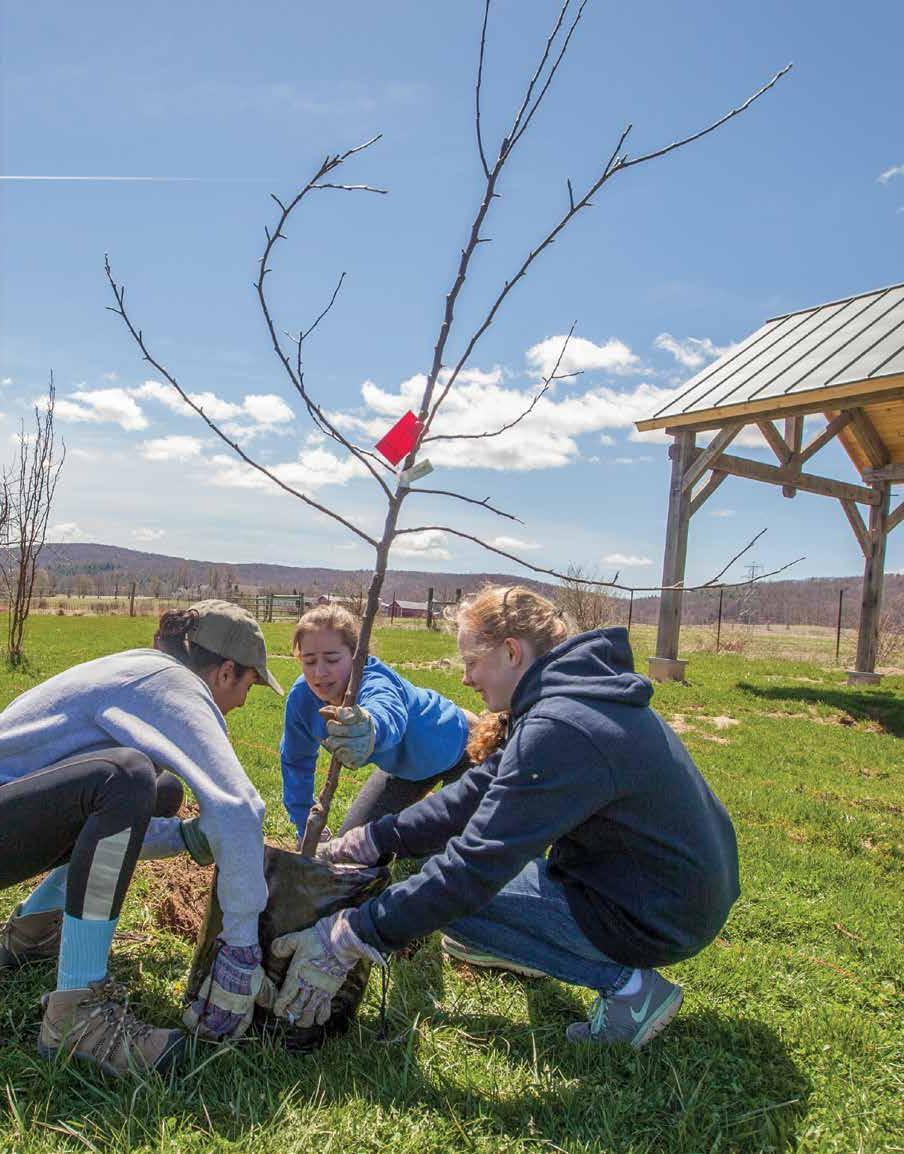

The natural world is a part of Hotchkiss as much as Hotchkiss is a part of the natural world. The School’s exceptional physical features include the 200-acre
Beeslick Brook Woods, consisting of white pine, hemlock, mixed hardwoods, several hemlock groves, and wetlands; 287 acres of farmland and fields on Fairfield Farm; and shorefront on 348-acre
Lake Wononscopomuc, the deepest natural lake in Connecticut.
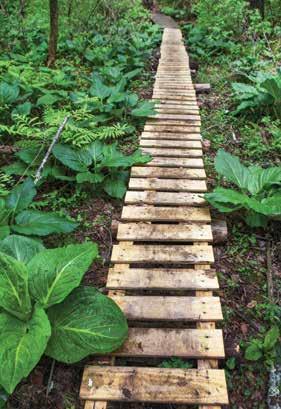
Hotchkiss has long sought to incorporate environmental stewardship into every aspect of School life and to be a leader in sustainability among independent secondary schools. As an institution, over the last 10 years the School has reduced its carbon footprint by 40 percent even as it has added students, buildings, and other infrastructure.
“Living and working in a community that is producing renewable energy, growing food, building soil, and sequestering carbon inevitably supports a student and faculty mindset and spirit that are regenerative, creative, and entrepreneurial,” says Josh Hahn, director of strategic initiatives and assistant head of school.
As a learning community, the School’s focus on the environment has led to everexpanding academic and co-curricular offerings, including sustainability initiatives that benefit the region.
“We know there are two surefire ways to engage students in environmental issues: first, by facilitating positive direct experiences with the natural world; and second, by supporting students in grappling with meaningful problems that influence their daily lives,” says Hahn. “With our natural resources and environmentallysensitive and innovative infrastructure, the Hotchkiss campus is set up beautifully to support this aspect of our mission.”
“The presence of three distinct ecosystems on our campus as sources of study is remarkable,” says Mario Williams ’12, instructor in environmental science. “We have a tremendous opportunity, and an equal obligation, to care for them.”
Onboarding green energy solutions is among the most significant ways the School has cut emissions. In 2012, the School built a green biomass central heating facility that runs on locally and sustainably sourced wood chips and produces nearly all of the School’s heat and hot water (see p. 37).
Two solar arrays on campus power the Fairfield Farm and provide one-third of the electricity at the Mars Athletic Center (MAC). Excess power is sold back to the grid, offsetting the costs of energy that must be purchased during peak periods. Thanks to participation in the Cleaner Connecticut Power Grid, 35 percent of our electricity comes from wind.
Other important sustainability initiatives include increasing recycling and reducing solid waste on campus and LED-retrofitting most indoor and outdoor lighting. Composting, which was placed on hold last year due to COVID protocols, will also resume. All new buildings are required to meet stringent environmental standards. The Esther Eastman Music Center and renovated Monahan Hall, Flinn, Edelman, and Redlich dormitories are all LEEDcertified. While the efficiency, economic, and environmental benefits driven by these enhancements are valuable on their own, providing students with access to green infrastructure through their academic coursework adds a significant dimension to their education.
THE CURRICULUM
“It is important that as an institution, we model what students are learning in the classroom. We teach about important environmental issues like climate change, and if we don’t demonstrate that we are at least grappling in real ways with these issues, it creates a disconnect that does a disservice to our academic program,” says Hahn.
Last year, the School’s decision to move away from the AP curriculum in Environmental Science made room for faculty to develop a series of new electives that take advantage of Hotchkiss’s natural physical spaces as well as the infrastructure the School has built.
“The AP curriculum has great strengths, but because it is a one-size-fits-all national curriculum, it was difficult to go as deep into the ecosystems of Hotchkiss as we wanted to,” says Chris Oostenink P’17,’20, instructor in environmental science. “Now we have a whole group of deeply interesting classes that allow us to dive into the lake, the forest, the farm, and their individual dimensions.”
Williams adds, “The School’s commitments to develop our builtinfrastructure, like the Biomass Heat Facility and Fairfield Farm, ensure that students have places to explore theoretical ideas and concepts in very tangible ways.”
At any given time, between 50 and 90 students are engaged in science courses that include Conservation Biology, Climate and Global Change, Agroecology, Limnology, and Forest Ecology. In the humanities, students can take Environmental Economics or, for the first time, Sustainable Food Systems. The significance of these course offerings lies in the fact that they are interdisciplinary, as environmental issues are themselves. This broad array of classes pushes students to transfer their mastery of content from one discipline to another. Students can also participate in clubs, such as Students for Environmental Action (SEA) (see p. 41), or the Fairfield Farm Ecosystem and Adventure Team (FFEAT) co-curricular.
Bridget Lawrence-Meigs joined Hotchkiss as the new Farm Manager this year (see p. 38), and she appreciates that the School’s commitment to addressing climate change includes giving students opportunities to be part of the solution. “Hotchkiss is inviting students to think about the fact that we can’t compartmentalize environmental problems any more. They are intertwined with so many other issues,” Lawrence-Meigs says. “But we are not just talking about climate change — we are thinking about how we can do something about it.”
“Teenagers hate hypocrisy. If we are serious about teaching our students about climate change, then we have to demonstrate an institutional commitment as well. Otherwise, we undermine the educational experience,” adds Hahn.
This year, Hotchkiss plans to update the School’s greenhouse gas inventory in service of creating an aggressive new carbon reduction strategy. The next phase requires reducing electricity use, vehicle use, and air travel, among other initiatives. “We have picked much of the low-hanging fruit, so the next step will be more difficult,” acknowledges Hahn. “But our students are leaders, and these are the issues they are going to be grappling with in the future.”

—JOSH HAHN, DIRECTOR OF STRATEGIC INITIATIVES AND ASSISTANT HEAD OF SCHOOL
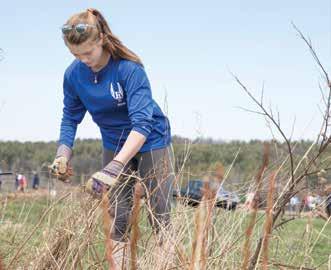
Feeding body and mind
FAIRFIELD FARM & THE HOTCHKISS DINING HALL
Perusing the salad bar in the Hotchkiss Dining Hall on a typical day this fall, students and faculty were greeted with a wealth of choices, including spinach, salad greens, turnips, cherry tomatoes, and green beans, all grown a mile away on the School’s Fairfield Farm.
Hotchkiss purchased the 260-acre farm in 2004. Six years later, the School expanded the Farm with an additional 27 acres of land and four buildings. The Farm has grown to be not just a supplier of food, but also a rich educational source. “When we look at where we started out and our strategic plan, we’ve been quite successful in achieving what we set out to achieve,” says Director of Dining Services Mike Webster.
Every winter, a team from Dining Services and the Farm meets to plan out the crops to be grown for the following year. This fall’s crops have included lettuce, tomatoes, hot and sweet peppers, green beans, turnips, radishes, kohlrabi, carrots, potatoes, squash, and raspberries. The Farm provides 30 percent of the produce served in the Dining Hall in the growing season, from April to November, and seven percent of the produce served yearly.
Hotchkiss also sources 100 percent of its grass-fed beef from the Farm, where local farmer Alan Cockerline keeps a herd of cattle. Working with Cockerline, who also runs a small farm stand and sells his beef to local restaurants, connects the School with the Lakeville community and ensures that we are spending our dollars locally. The Farm also hosts pigs, chickens, and, occasionally, turkeys.
Overall, 50 percent of the food served in the Dining Hall is sourced from suppliers within 100 miles of campus. In addition to reducing the School’s carbon footprint, buying locally serves to protect Hotchkiss from global supply-chain disruption. This problem has become acute during the pandemic.
“My local food supply chain runs as efficiently as it ever has,” says Webster. “We will always have local milk, meat, grains, and seasonal vegetables in the dining hall.” When beef prices spiked this fall, the School’s costs remained flat, and there was no interruption in supply. The School sees this resilience across the food system thanks to deep relationships with local farmers.
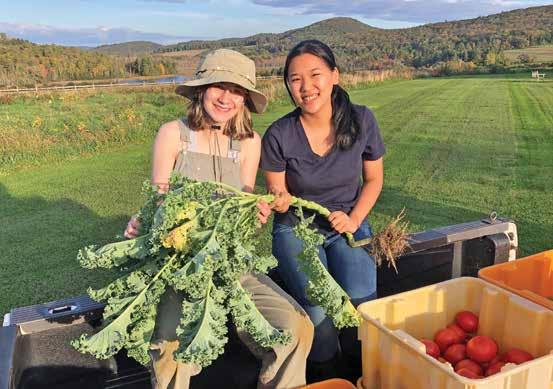
FFEAT leader Arielle Szycher ’22 (left) with Nancy Young Park ’22 (right)
PHOTO: BRIDGET LAWRENCE-MEIGS
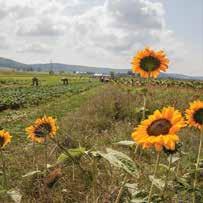
“I remember how I smelled of cherry tomatoes
ALL OVER MY BODY AFTER COMING OUT OF THE ‘TOMATO JUNGLES,’ AND HOW I HAD MUD ALL OVER MY HANDS (AND IN MY FINGERNAILS) AFTER DIGGING METICULOUSLY IN THE FIELD SEARCHING FOR POTATOES. BUT I FEEL SO FULFILLED AND GENUINELY HAPPY REALIZING HOW OUR EFFORT HERE AT FFEAT IS NOURISHING A BIGGER COMMUNITY THAT WE ARE A PART OF.” —SUSAN YU ’25

The flip side of this, points out Sidran, is that by keeping dollars in the community, the School is operating as a good citizen of the Lakeville area. “During the uncertainty of COVID, farmers knew we were going to continue to support them. Those dollars go to our gas stations, our markets, and our families. Hotchkiss is really intentional about supporting the local economy,” she says.
“That’s a pretty amazing thing just in terms of dollars and sense value,” says Oostenink of the bounty that ends up in the Dining Hall, “but we also hope that when people see that ‘Fairfield Farm’ sign, they are connecting the fact that these better tomatoes are not coming from a factory farm.” The Farm not only delivers higher-quality produce, it helps reduce our carbon footprint.
FFEAT
If you’ve been on campus around dinner time, you’ve probably seen a few students proudly sporting Carhart “FFEAT” jackets. FFEAT stands for Fairfield Farm Ecosystem and Adventure Team, a twoseason co-curricular that runs in the fall and spring. “We’re not just playing farm out here,” says Webster. “We farm eight acres of crops, and it’s a lot of work. The FFEAT students are the production team and, without them, we wouldn’t be able to produce what we do.”
The idea for a co-curricular on the Farm was the vision of Coordinator of Faculty Mentorship Charlie Noyes ’78, P’03,’07. The previous Farm Manager, Ellie Youngblood ’10, helped further develop the program. With LawrenceMeigs and Sidran assuming leadership of the program, “the School has built strength on strength,” says FFEAT co-leader Amanda McClure P’18,’22. “The program’s future is bright under their leadership.” Throughout the fall students are out in the fields harvesting crops. They wash, prepare, and store all the food for transportation to the Dining Hall. They press apples for cider, and they care for the livestock. Occasionally, students will help slaughter animals, a task that is accompanied by much discussion and reflection. In the spring, FFEAT students prep the fields, plant seedlings, and help with projects like building a new chicken coop. Twenty-five students participate in FFEAT each term, and the program is often oversubscribed. The co-curricular attracts students from all grades, international students, and students from urban and rural areas. McClure says many students choose FFEAT because it doesn’t require previous experience, tryouts, or cuts, and it offers the opportunity to try something new. “We get a lot of repeat customers.”
IN THE TOMATO GREENHOUSE, I OFTEN FIND MYSELF TANGLED UP IN THE DENSER SIDE OF THE CHERRY TOMATO ROW; THE ONES I EAT HERE AND THERE MOTIVATE ME TO GO ON, THOUGH IN MANY OF THE PLACES I WORK, I AM ALWAYS PLEASANTLY SURPRISED WHEN I SEE SOME FAMILIAR ITEMS FROM THE DINING HALL REFLECTED IN THE FARM, SUCH AS THE TURNIPS THE OTHER DAY. AND WHEN THE DAY’S WORK IS DONE AT THE FARM AND I TAKE A LOOK AROUND AT THE LANDSCAPE,
I sometimes feel as if I am in some sort of painting.”
—FRANCIS EVERSOLE ’23
GIVES ME THE CHANCE TO ESCAPE THE CHAOTIC BOARDING SCHOOL WORLD AND FOCUS MY UNDIVIDED ATTENTION ON PULLING CARROTS OUT OF THE GROUND, OR FEEDING TURKEYS, OR PICKING RIPE TOMATOES OFF THEIR VINES.”
— ARIELLE SZYCHER ’22,
FFEAT CO-CAPTAIN
“Being at the farm is not just connecting with the idea of nature;
IT IS REALIZING THAT YOU ARE A PART OF IT AND THAT EVERYONE IS CONNECTED TO ONE ANOTHER, THROUGH MAKING A NEW FRIEND OR HARVESTING A NEW PLANT.” —RICKY SHI ’23
A SPACE FOR LEARNING
The Farm not only feeds the School, it also enriches a wide array of academic classes. Chemistry students conduct soil testing and learn about how pH affects nutrient levels. This year, Agroecology students will measure carbon sequestration in the soil and share that data with other local farms. Students studying Native American Literature travel to the Farm to learn about the Three Sisters, a traditional indigenous garden of corn, beans, and squash. One year, a French class mucked out the pig pen while reading a novel about Chinese boys relocated to a rural village during the Cultural Revolution. Art classes take trips to the farm to paint, draw, or take photographs. And, this year, Sidran is teaching Sustainable Food Systems in the fall and spring, which allows students to use the Farm as an entryway to larger questions about how food systems work.
Lawrence-Meigs gives the recent example of a group of students who came out to the Farm to discuss this year’s all-School Read, Braiding Sweetgrass, by Robin Wall Kimmerer. A student remarked that the conversation was much more meaningful for her because it took place on the Farm and not in a classroom. “It was a reminder of how powerful this place can be,” says Lawrence-Meigs. “The Farm provides a space for people to ask questions about the environment and food production. That sparks curiosity, and once you are curious you can take that in a million different directions.”
A REGENERATIVE SPACE
Just as the Farm is regenerative for the soil and plants, Hahn hopes it can provide that function for the Hotchkiss community. Already, the Farm is used for workshops, retreats, and other campus gatherings. “The Farm gets you outside the gates,” Hahn says, “It is a space where we can be more creative and reflective.”
McClure sees this process happen on the Farm all the time, where students have the opportunity to make connections and develop empathy. “It’s humble, but you’ll have a day when you’re weeding in a drizzle with this diverse group of kids from all over the world, just working quietly together, and maybe you find a listening ear, or maybe you are the listening ear, and by the time you get to the end of the row, something magical has happened.”
“The farm is the best way for me to meet new people;
FROM HARVESTING TOMATOES IN THE GREENHOUSE, TO PICKING ONIONS OUT IN THE FIELD, I HAVE MET MANY PEOPLE WHO I CAN CONFIDENTLY CALL MY FRIENDS!”
—CHARLOTTE HAZELTON ’22
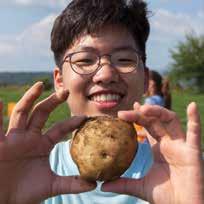
“It’s good to play in the dirt again!”
—COOPER ROH ’22, FFEAT CO-CAPTAIN
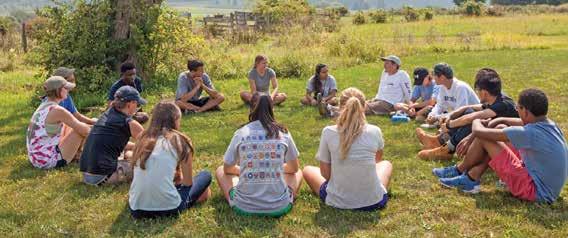
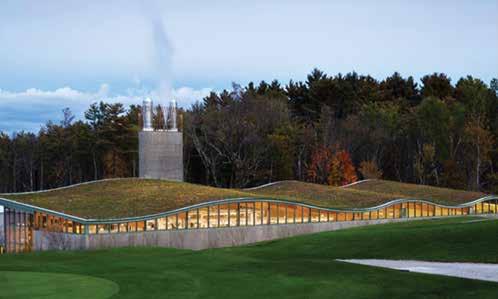
Biomass: Connecting students to our energy systems
Ten years ago, Hotchkiss needed to update its aging central heating system, parts of which were more than a century old. Rather than go the less-costly route of replacing the oil-fired boiler plant, the School chose green energy. The result, completed in 2012, is the School’s state-of-the-art Biomass Heating Facility. As of 2021, the return on the $14-million facility has been significant savings in energy costs, reduction of greenhouse gas emissions, and unmatched educational opportunities for students.
“The biomass facility is slashing our carbon footprint by 40 percent and saving us at least a half-million dollars each year compared to what we would be spending if we burned oil,” says Hahn. “These savings have now fully offset the cost of the initial investment in the biomass facility.”
Through the Biomass Facility, Hotchkiss supports local mills and, by extension, local foresters and sustainably managed forests. The wood chips aren’t traveling far, so less gas is used than when the School was purchasing oil. And, by relying on a locally sourced form of energy, Hotchkiss is protected from market fluctuations.
Perhaps the most significant way that the Biomass Heat Facility sets Hotchkiss apart from our peer schools is what it offers students interested in climate science. In his Climate and Global Change course, Mario Williams brings his students to the facility to teach about energy and sustainability. Students learn about grid source energy and how the Biomass Facility has allowed Hotchkiss to transition away from the grid. They get comfortable with energy conversions and manipulating mathematical units. And they grapple with questions such as: what are the environmental impacts of different fuel sources? What are the benefits of biomass versus nuclear energy versus hydrocarbons like coal and natural gas?
“The work they are doing becomes far more tangible and meaningful to them,” says Williams. “They head back to their dorms and they are able to tell their peers or their parents, ‘I visited the Biomass Facility, I spoke with professionals, and now I know where the heat comes from for Dana or Edelman or Buehler or Flinn.’” Williams says his students are learning professionallevel skills, such as how to conduct field work, analyze data, and effectively present their findings. “We would not be able to accomplish these high-level goals without having the spaces to do this work,” he says.
“The biomass plant is emblematic of our whole philosophy. We aim to create a campus that by its nature teaches and reinforces what we teach and our mission. It is an experiential venue and opportunity for important student learning. It saves us money, allows us to support the local community, and contributes to carbon reduction. We aim to manifest those same values in all our energy management, food purchasing and land and water management practices,” explains Hahn. “If we can find elegant solutions like the plant, and share them with our students, there is plenty to be hopeful for in the future.” H

Growing Community
NEW FARM MANAGER BRIDGET LAWRENCE-MEIGS
IS SOWING SEEDS OF SUSTAINABILITY
BY WENDY CARLSON
Bridget Lawrence-Meigs has been immersed in the natural world virtually all her life. She grew up at nearby Millbrook School in Millbrook, NY, where her father was the director of The Trevor Zoo and her mother promoted sustainability initiatives and taught environmental science. In their backyard they kept a garden where she pulled weeds and marveled at the power of earthworms to nurture the soil. She learned that a farm is an ecosystem comprising many different organisms –– some of them friend and others, foe.
These early lessons in agriculture served her well when she became the new farm manager at Fairfield Farm last summer.
Since arriving, she has dealt with an invasion of potato beetles, chased off raccoons preying on baby chicks, managed a particularly wet growing season, and adapted to the Farm’s persnickety 1952
Farmall tractor.
Those daily challenges are constant reminders that farm life is unpredictable. But her role at Hotchkiss extends far beyond managing
Fairfield Farm’s 287 acres of farmland and fields. This fall, she is engaged in sharing her extensive knowledge of sustainable agriculture, equitable food systems, and good stewardship practices with the
Hotchkiss community.
“Bridget is a rockstar,” says Director of Dining Services Mike
Webster. “She has a breadth of experience. Not only is she working in the fields and processing our food, she is thinking about big picture environmental issues.”
Lawrence-Meigs earned her B.S. in biology in 2001 from Queen’s
University in Kingston, Ontario. Her real passion for farming took root in Kenya during a semester abroad program with the Canadian
PHOTO: WENDY CARLSON Field Studies in Africa Programme. The experience inspired her to study how school gardens can play a role in addressing childhood food insecurity. She later graduated from Cornell with a master’s degree in sustainable agriculture before gaining hands-on experience at several different farms and non-profits.
In 2011, she launched a campus farm at Stonehill College. There, she worked closely with students, growing and donating 12,00015,000 pounds of more than 100 varieties of vegetables, flowers, and herbs grown on a 1.5 acre parcel of land. The produce was donated to help alleviate food insecurity in the surrounding communities.
Similarly, at Hotchkiss she is guiding students in the Fairfield Farm Ecosystem and Adventure Team (FFEAT), teaching them about sustainable agriculture and working with them to provide ethically grown, organic food for the Hotchkiss community.
“She’s incredibly skilled as a farmer,” says FFEAT co-leader Amanda McClure. “It’s rare to find someone who is good with both plants and livestock. Most importantly, she has experience working with students, and she has a wonderful rapport with them.”
Lawrence-Meigs is equally committed to environmental sustainability. “It is clear that the Hotchkiss is actively engaging with global issues like climate change, and that the whole community values the farm and recognizes its role in educating students and connecting them to the natural environment,” she says.
In addition, Lawrence-Meigs has been encouraged by the School’s dedication to equity and inclusion, and its efforts to make the Hotchkiss farm experience more accessible.
“I look forward to partnering with Mike Webster and Director of Diversity and Inclusion Yassine Talhaoui to connect the community both on campus and in the surrounding towns around the food grown at the farm –– offering opportunities to share food stories, histories, and cultures that reflect the diversity of the School’s population,” she says.
Lawrence-Meigs is passionate about food insecurity and justice. “It’s important to provide students, faculty and staff the opportunity to think about these issues, to volunteer, and play a role in supporting a healthy food system in the Lakeville community,” she says.
Her long-term goal is to help students learn more about where food comes from and why food choices matter, both environmentally and socially. “I love seeing how students’ farm work teaches them appreciation for their food. In the process, they also gain the satisfaction of completing a job as a team, perhaps with a callus or two to show for it!”
Bridget lives at Fairfield Farm with her husband, Jim, their dog, Zuri, and their calico cat, Xela. H
FAIRFIELD FARM EDUCATION COORDINATOR AMY SIDRAN
Taking a Holistic Approach to Learning
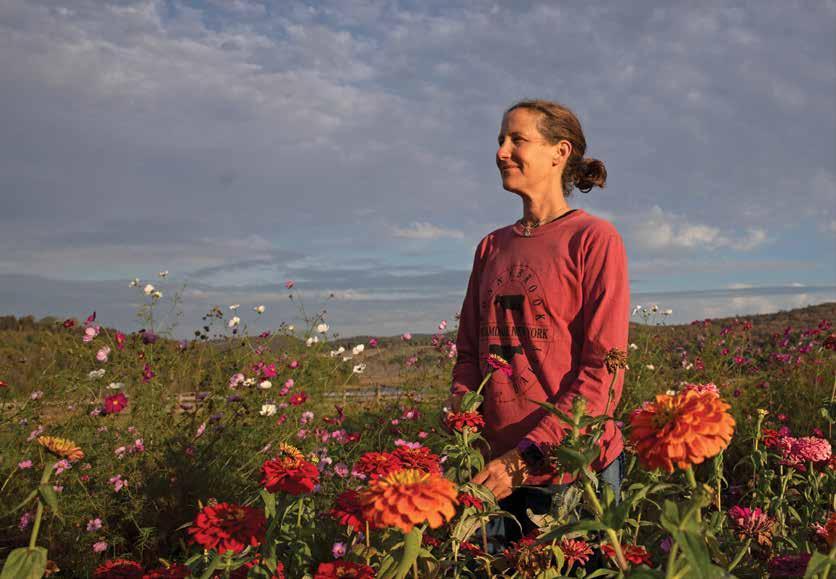
BY JULIA ELLIOTT
When Amy Sidran thinks about the experience that most prepared her for her role as Fairfield Farm Education
Coordinator, she doesn’t mention her master’s degree in sustainable agriculture; she skips over her work on different farms across the country; and, she doesn’t discuss her experience as a middle- and high-school science teacher. What she does talk about is living and working overseas in Costa Rica,
Bolivia, and the Dominican Republic, and how these experiences taught her, in the words of novelist Chimamanda Adichie,
“the danger of a single story.” “Going overseas and seeing things firsthand, I saw that the world is much more complex than the single-story way I had been seeing it. We all have all these layers,” she says, “and I bring that consciousness to my experiences with students. I know that together, by sharing our stories, we can always find common ground.” As Farm Education Coordinator, Sidran is tasked with ensuring that faculty and students make the most of the Farm as a site of learning. She is also one of four faculty co-leaders of the Fairfield Farm Ecosystem and Adventure Team co-curricular (FFEAT).
“Amy thinks about the Farm as a system,” says Farm Manger Bridget Lawrence-Meigs, “so she sees the environmental impacts, the social impacts, the economic impacts, and she is really excited about thinking holistically about how the Farm can be used by all academic departments at Hotchkiss.” Perhaps the best example of how Sidran is incorporating the Farm into Hotchkiss’s curriculum is her Sustainable Food Systems class, a new upper-level elective in the Humanities and Social Sciences department. The class uses Hotchkiss’s food system as a way to explore how food systems affect economies and communities. The class visits Fairfield Farm, the dining hall, local farms, and food pantries. The trips enable them to dig into issues as varied as immigration, climate change, food insecurity, and whether organic is really the best way to go. Recently, while discussing whether it was better for the environment to eat a vegan burger from the supermarket or a grassfed beef patty from Fairfield Farm, many students in the class had to question their assumptions. “And that’s the highest level of inquiry, I think,” says Sidran, “to ask, ‘Who is teaching me this and why? Have I heard all the sides, or have I only heard one side?’ It goes back to the danger of the single story. It’s not so black and white, and I want them to understand that these problems are so gray.” Sidran’s goals for her class, for FFEAT, and for faculty and students who visit the Farm in other capacities, is that they will gain a greater understanding of where their food comes from and build community around the Farm. “It’s having those shared experiences that bring us together around food,” she says, “because we all eat food; we all need to be nourished, and that connects all of us.” H
STUDENTS FOR ENVIRONMENTAL ACTION (SEA)
Inspiring the Next Generation of Environmental Leaders
WITH MORE THAN 80 CLUBS TO CHOOSE FROM
AT HOTCHKISS, THERE ARE MANY WAYS TO ENGAGE IN GLOBAL ISSUES. STUDENTS IN SEA
ADDRESS CLIMATE CHANGE BY FOCUSING ON
THE THREE Rs: REDUCE, REUSE, AND RECYCLE.
BY ROBERTA JENCKES
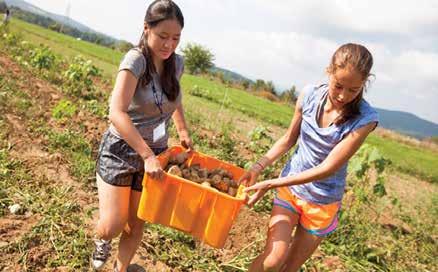
When she first arrived at Hotchkiss, Margo Donohue ’22 was overwhelmed with all the opportunities offered during her prep year. Then Annabelle Duval ’19, a proctor in her dorm and head of Students for
Environmental Action (SEA), invited her to come to their first meeting.
“The conversation was the most memorable part, completely outside of a classroom setting,” Donohue says. “Students were passionately diving into climate policy.
And they talked about Greta Thunberg’s impact as a speaker our age and made a connection to their Conservation Biology elective. It was electric and inviting and helped confirm that Hotchkiss was the place for me.
I became a board member my lower mid year, and have served as a co-head with Eliza Ross ’22 my upper mid and senior years.”
Donohue’s involvement echoes the spirit of environmentally conscious students in generations past, going back to the country’s first Earth Day in 1970. That year Hotchkiss joined other area high schools in creating a regional chapter of the Environmental Rescue Alliance, known as ERA. On Earth Day in April 1970, the group marched in Torrington, CT, collected soda cans in Salisbury and Lakeville, and distributed flyers door-to-door.
In 1976 and 1977, Hotchkiss held its first environmental program, a precursor to the School’s Eco Day, during which classes were cancelled Thursday through
Saturday and students attended a variety of lectures and films. Guest speaker programs featured Paul Ehrlich and Ralph Nader. By the mid-1980s Hotchkiss had incorporated environmental stewardship into its mission
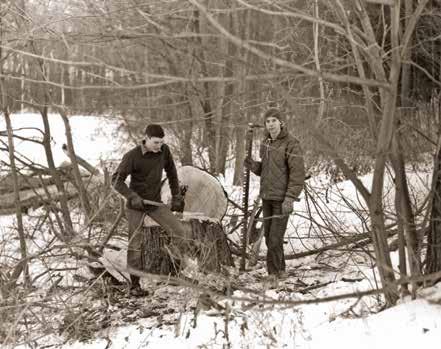
PHOTO: PRENTICE K. STOUT
statement, which read, in part, “We hope that our graduates will leave Hotchkiss with a commitment to serve others and to environmental stewardship.” The School’s mission statement today continues to reflect that goal, stating that all students will “exercise responsible citizenship through local and global engagement, service, and environmental stewardship.”
In 1990, faculty members Nancy Gaynor P’99,’04, instructor in human development and counselor, and Instructor in Philosophy and Religion Lou Pressman P’98 founded SEA. Later, Biology Instructor Jim Morrill P’87,’89 succeeded Pressman, and he and Gaynor served as SEA’s advisors for more than 20 years. Josh Hahn, director of strategic initiatives and assistant head of school, currently acts as advisor overseeing SEA’s activities, including the planning for Eco Day every spring.
Launched in 1993, Eco Day is a school-wide event held each April that features environmental speakers, films, and activities. Last year’s speaker, Dr. Gary Kofinas, professor emeritus at the University of Alaska Fairbanks, has expertise in the meaning of climate change for indigenous people living in rural villages of the North. On Eco Day itself, students and faculty work in teams to pick up roadside trash, clear selected areas of invasive species, and complete other environmental projects including taking care of the Beeslick Woods, which is part of the club’s yearround activity.
Today, SEA focuses on the three “Rs”: reduce, reuse and recycle. In the 2020-21 school year, club members found creative ways to reuse and recycle the products the School used to safely and hygienically feed the community.
“One of SEA’s most profound reduction strategies for Hotchkiss’s carbon footprint was our food drive at the beginning of the school year, while everyone was in quarantine for two weeks,” co-head Eliza Ross says. “Every day, each student received three pre-set meals in plastic shopping bags, which often included a surplus of food that people did not eat. We encouraged everyone to save their nonperishable foods and drinks, plastic water bottles, plastic utensils, and disposable bags, which we then collected from each dorm to donate to a local food pantry. Once dining was back to graband-go, we provided each student with a reusable canvas bag to use instead of plastic disposables.”
Perhaps not surprisingly, students often carry their acquired knowledge and passion for the environment throughout their college years and into their careers. Cakey Worthington ’09, a co-head of SEA during her years at Hotchkiss, today serves as the director of forest operations for the Bluesource Sustainable Forests Company, a leader in climate change and low-carbon environmental products and services.
“My time at Hotchkiss was definitely formative for my career track in conservation and the environment,” says Worthington, who studied ecology in college, worked in land conservation, and then pursued a joint master’s in environmental management and master’s in forestry degree at Duke University. For the past several years, she has been helping large private forestland owners throughout the U.S. expand and improve their sustainable forest management practices and earn credit for their stewardship through forest carbon credit generation.
“I think it was a combination of my leadership in SEA, taking AP environmental science with former teacher Jim Morrill, and being actively involved in the Outing Club. I remember really enjoying having a community of people to discuss environmental issues and brainstorm ways to bring environmental awareness and action to the school. I spent time in the environment, learning about how it worked, and how to help conserve and improve it in the long term.” H
Hotchkiss has always had a strong conection to the land, dating back to the Woods Squad. On left, James C. Hemingway ’63 and William Shoaf ’63 clear and cut trees in Beeslick Woods (1961).





